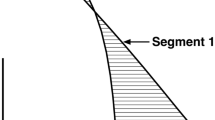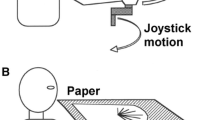Abstract
The relationship between wrist kinematics, dynamics and the pattern of muscle activation were examined during a two-joint planar movement in which the two joints moved in opposite directions, i.e. elbow flexion/wrist extension and elbow extension/wrist flexion. Elbow movements (ranging from 10 to 70 deg) and wrist movements (ranging from 10 to 50 deg) were performed during a visual, step-tracking task in which subjects were required to attend to the initial and final angles at each joint. As the elbow amplitude increased, wrist movement duration increased and the wrist movement trajectories became quite variable. Analysis of the torques acting at the wrist joint showed that elbow movements produced reaction torques acting in the same direction as the intended wrist movement. Distinct patterns of muscle activation were observed at the wrist joint that were dependent on the relative magnitude of the elbow reaction torque in relation to the net wrist torque. When the magnitude of the elbow reaction torque was quite small, the wrist agonist was activated first. As the magnitude of the elbow reaction torque increased, activity in the wrist agonist decreased significantly. In conditions where the elbow reaction torque was much larger than the net wrist torque, the wrist muscle torque reversed direction to oppose the intended movement. This reversal of wrist muscle torque was directly associated with a change in the pattern of muscle activation where the wrist antagonist was activated prior to the wrist agonist. Our findings indicate that motion of the elbow joint is an important consideration in planning wrist movement. Specifically, the selection of muscle activation patterns at the wrist is dependent on the relative magnitude and direction of the elbow reaction torque in relation to the direction of wrist motion.
Similar content being viewed by others
References
Benecke R, Meinck H-M, Conrad B (1985) Rapid goal-directed elbow flexion movements: limitations of the speed control system due to neural constraints. Exp Brain Res 59: 470–477
Berardelli A, Rothwell JC, Day BL, Kachi T, Marsden CD (1984) Duration of the first agonist EMG burst in ballistic movements. Brain Res 304: 183–187
Brown SH, Cooke JD (1981) Amplitude and instruction dependent modulation of movement-related electromyographic activity in humans. J Physiol (Lond) 316: 97–107
Brown SH, Cooke JD (1990) Movement-related phasic muscle activation. I. Relations with temporal profile of movement. J Neurophysiol 63: 455–464
Cooke JD, Brown SH (1994) Movement-related phasic muscle activation. III. The duration of phasic agonist activity initiating movement. Exp Brain Res 99: 473–482
Dempster WT (1955) cited in: Gowitzke BA, Milner M ed (1988) Understanding the scientific bases of human movement, 2nd edn Williams and Wilkins, Baltimore
Flanders M (1991) Temporal patterns of muscle activation for arm movements in three-dimensional space. J Neurosci 11: 2680–2693
Hallett M, Shahani BT, Young RR (1975) EMG analysis of stereotyped voluntary movements in man. J Neurol Neurosurg Psychiatry 38: 1154–1162
Hoffman DS, Strick PL (1990) Step-tracking movements of the wrist in humans. II. EMG analysis. J Neurosci 10: 142–152
Hollerbach JM, Flash T (1982) Dynamic interactions between limb segments during planar arm movements. Biol Cybern 44: 67–77
Hong D, Corcos DM, Gottlieb GL (1994) Task dependent patterns of muscle activation at the shoulder and elbow for unconstrained arm movements. J Neurophysiol 71: 1261–1265
Kaminski T, Gentile AM (1989) A kinematic comparison of single and multijoint pointing movements. Exp Brain Res 78: 547–556
Karst GM, Hasan Z (1991) Timing and magnitude of electromyographic activity for two-joint arm movements in different directions. J Neurophysiol 66: 1594–1604
Koshland GF, Hasan Z (1994) Selection of muscles for initiation of planar, three-joint arm movements with different final orientations of the hand. Exp Brain Res 98: 157–162
Eacquaniti F, Soechting JF (1982) Coordination of arm and wrist motion during a reaching task. J Neurosci 2: 399–408
Mustard BE, Lee RG (1987) Relationship between EMG patterns and kinematic properties for flexion movements at the human wrist. Exp Brain Res 66: 247–256
Soechting JF (1984) Effect of target size on spatial and temporal characteristics of a pointing movement in man. Exp Brain Res 54: 121–132
Stein RB, Cody FW, Capaday C (1988) The trajectory of human wrist movements. J Neurophysiol 59: 1814–1830
Virji-Babul N, Cooke JD, Brown SH (1994) Effects of gravitational forces on single joint arm movements in humans. Exp Brain Res 99: 338–346
Virji-Babul N, Cooke JD (1995) Influence of joint interactional effects on the coordination of planar two-joint arm movements. Exp Brain Res
Wadman WJ, Denier van der Gon JJ, Derksen RJ (1980) Muscle activation patterns for fast goal-directed arm movements. J Hum Mov Stud 6: 19–37
Author information
Authors and Affiliations
Rights and permissions
About this article
Cite this article
Cooke, J.D., Virji-Babul, N. Reprogramming of muscle activation patterns at the wrist in compensation for elbow reaction torques during planar two-joint arm movements. Exp Brain Res 106, 169–176 (1995). https://doi.org/10.1007/BF00241366
Received:
Accepted:
Issue Date:
DOI: https://doi.org/10.1007/BF00241366




